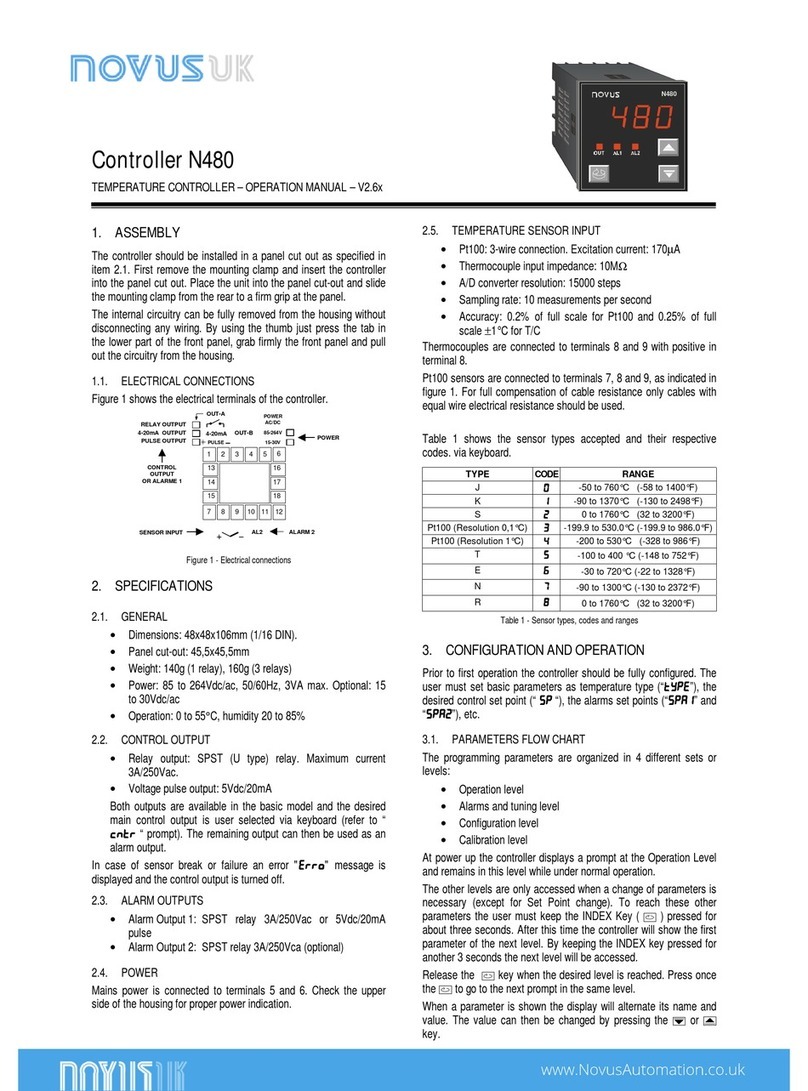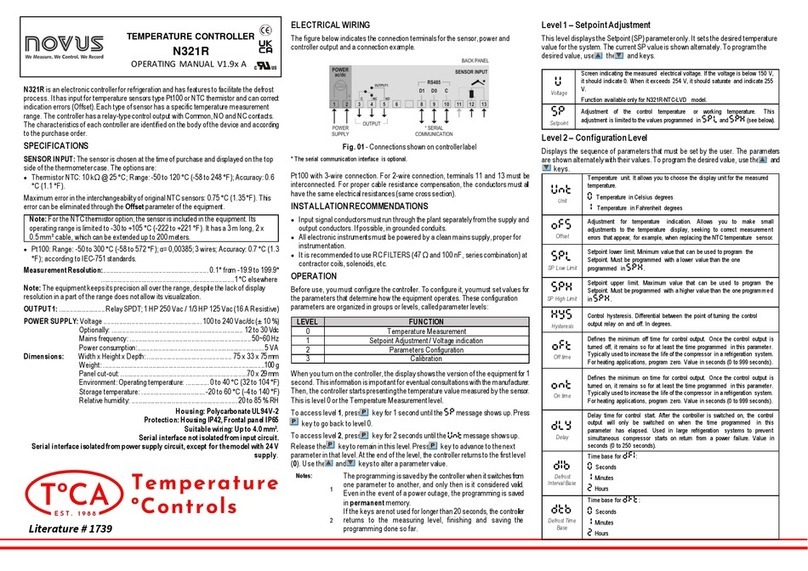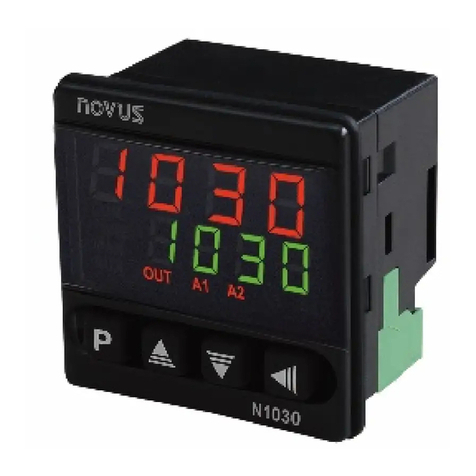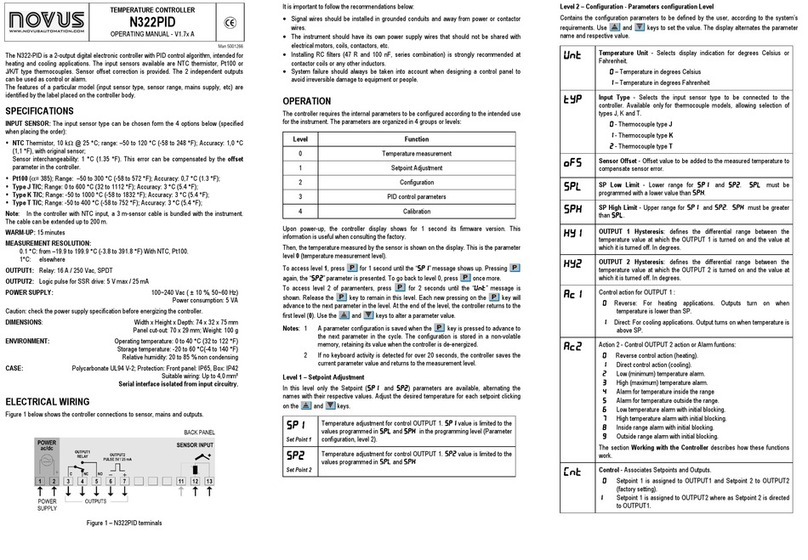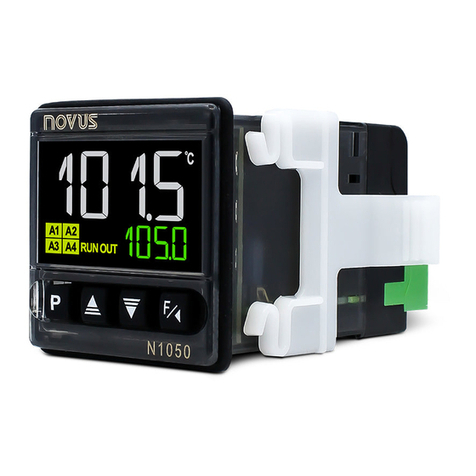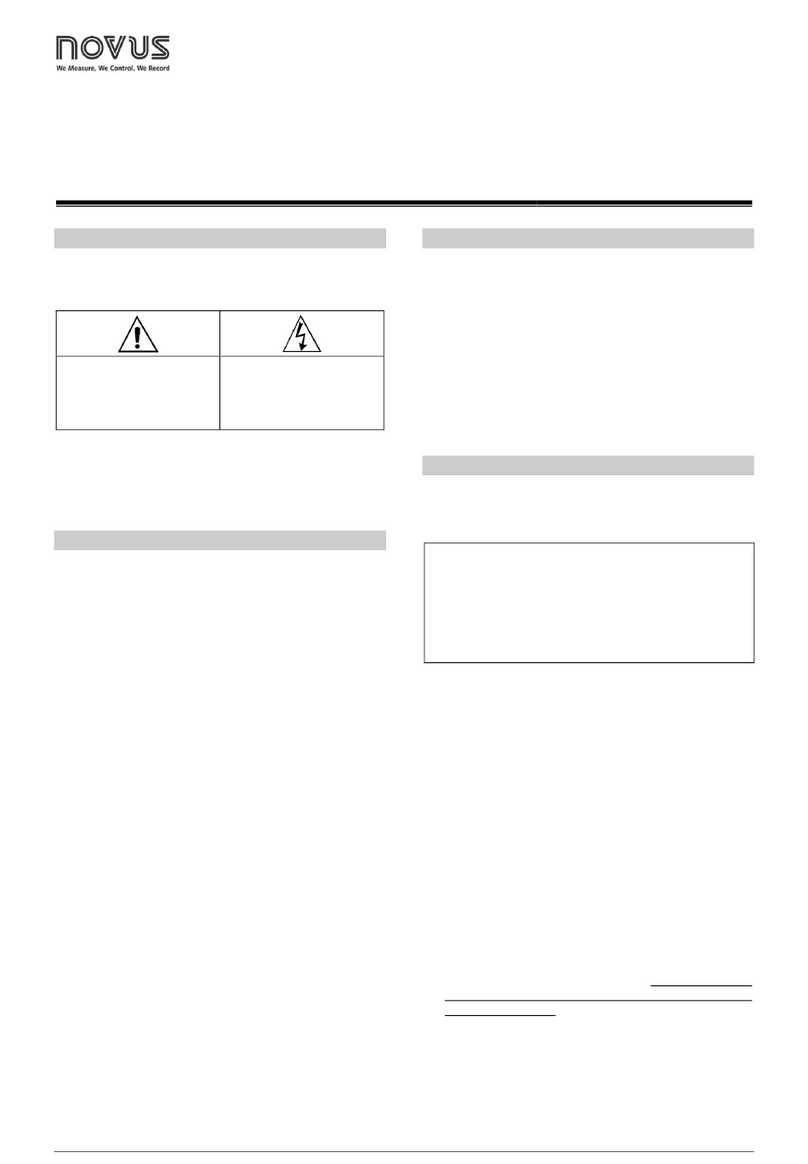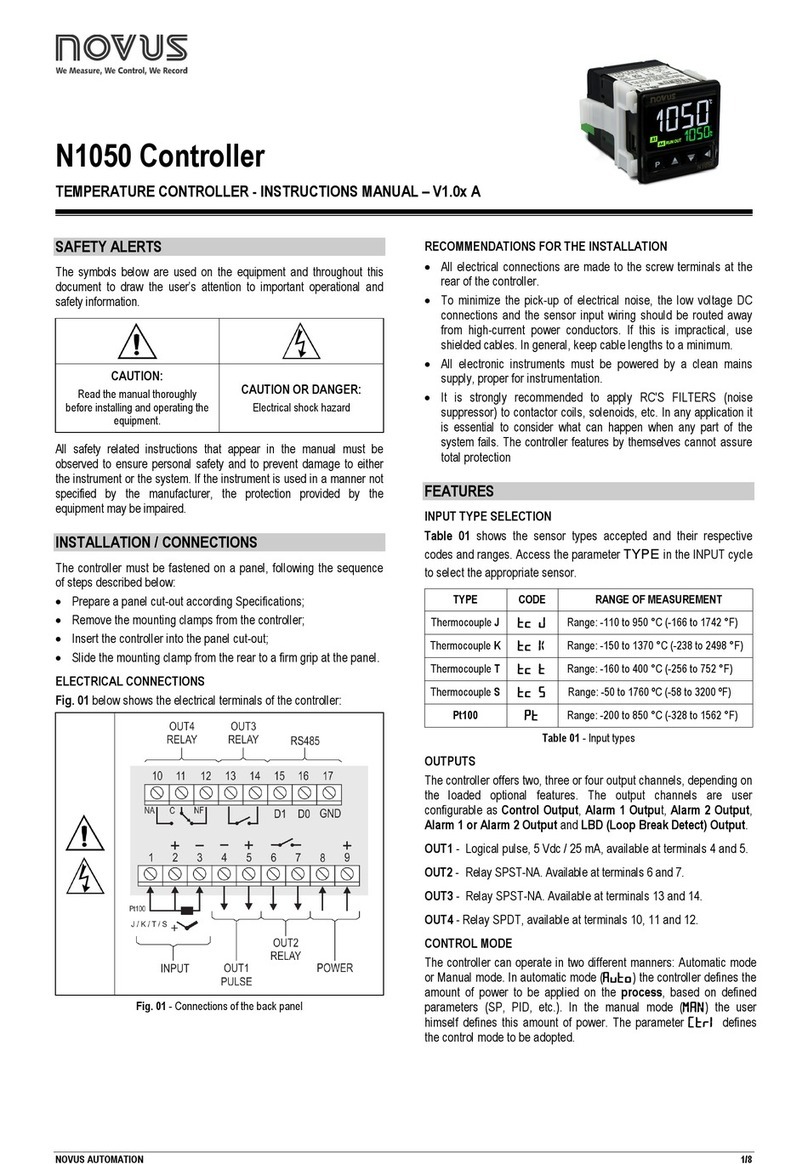
TEMPERATURE CONTROLLER
N323
OPERATING MANUAL - V1.8x G
Man 5001279
SAFETY SUMMARY
The symbols below are used on the equipment and throughout this document to draw the
user’s attention to important operational and safety information.
CAUTION or WARNING:
Read complete instructions prior to
installation and operation of the unit.
CAUTION or WARNING:
Electrical Shock Hazard
All safety related instructions that appear in the manual must be observed to ensure personal
safety and to prevent damage to either the instrument or the system. If the instrument is used
in a manner not specified by the manufacturer, the protection provided by the equipment may
be impaired.
SPECIFICATIONS
INPUT SENSOR: The sensor is chosen by the user at the time of purchase and is presented
on the upper side of the equipment box. The options are:
•Thermistor NTC, 10 k
@ 25 °C; Range: –50 to 120 °C (–58 to 248 °F); Accuracy: 0.6 °C
(1.1 °F);
Maximum error in the interchangeability of original NTC sensors: 0.75 °C (33.35 °F). This
error can be eliminated through the offset parameter of the equipment.
Note: For the NTC thermistor option, the sensor comes with the equipment. Its operating
range is limited to –30 to +105 °C (–222 to +221 °F). It has cable of 3 m in length, 2 x 0.5
mm², and can be extended up to 200 meters.
•Pt100; Range: –50 to 300 °C (–58 to 572 °F);
= 0,00385; 3 wires;
Accuracy: 0.7 °C (1.3 °F); according to IEC-751 standards;
•Pt1000; Range: –200 to 530 °C (–328 to 986 ºF);
= 0,00385; 3 wires;
Accuracy: 0.7 °C (1.3 °F);
•Thermocouple type J; Range: 0 to 600 °C (32 to 1112 °F); Accuracy: 3 °C (5.4 °F);
•Thermocouple type K; Range –50 to 120 °C (–58 to 248 °F); Accuracy: 3 °C (5.4 °F);
•Thermocouple type T; Range: –50 to 120 °C (–58 to 248 °F); Accuracy: 3 °C (5.4 °F);
Thermocouples according to IEC-584 standards.
WARM-UP:................................................................................................................ 15 minutes
MEASUREMENT RESOLUTION:
From –19.9 to 199.9º with NTC, Pt100 and Pt1000: ................................................................ 0.1
Elsewhere: ............................................................................................................................ 1
Note: The equipment keeps its precision all over the range, despite the lack of display
resolution in a part of the range does not allow its visualization.
OUTPUT1:.............................. Relay SPDT; 1 HP 250 Vac / 1/3 HP 125 Vac (16 A Resistive)
OUTPUT2:......................................................................................Relay: 3 A / 250 Vac, SPST
OUTPUT3:......................................................................................Relay: 3 A / 250 Vac, SPST
POWER SUPPLY: ................................. 100~240 Vac (± 10 %) or 24 Vdc/ac (12~30 Vdc/ac)
............................................................Mains frequency: 50~60 Hz. Power consumption: 5 VA
Caution: check the power supply specification before energizing the controller.
DIMENSIONS:.......................................................... Width x Height x Depth: 74 x 32 x 75 mm
................................................................................. Panel cut-out: 70 x 29 mm; Weight: 100 g
ENVIRONMENTAL CONDITIONS:.....................................................0 to 40 °C (32 to 104 °F)
Maximum RH: 80 % up to 31 %, decreasing linearly to 50 % at 40 °C. Installation category II.
Pollution degree 2. Altitude < 2000 m.
CASE:............................... Polycarbonate UL94 V-2; Protection: Front panel: IP65, Box: IP42
....................................................................................................Suitable wiring: Up to 4.0 mm²
RS-485 digital communication; RTU MODBUS protocol (optional)
Serial interface not isolated from input circuitry.
Serial interface isolated from input circuitry, except in 24 V powered model.
The N323 is a 3-output digital electronic controller for heating and cooling applications. It is
available with NTC thermistor input sensor, Pt100, Pt1000 or J / K / Ttype thermocouple.
Sensor offset correction is provided. The 3 independent outputs can be used as control or
alarm. The features of a particular model (input sensor type, sensor range, mains supply, etc)
are identified by the label placed on the controller body.
ELECTRICAL WIRING
It is important to follow the recommendations below:
•Signal wires should be installed in grounded conduits and away from power or contactor
wires.
•The instrument should have its own power supply wires that should not be shared with
electrical motors, coils, contactors, etc.
•Installing RC filters (47 R and 100 nF, series combination) is strongly recommended at
contactor coils or any other inductors.
•The use of protection devices.
Fig. 1 below shows the controller connections to sensor, mains and outputs.
Fig. 1 – N323 terminals
Pt100 with 3 conductors: Terminals 11, 12 and 13 must have the same wire resistance for
proper cable length compensation. For 2 wire Pt100, short circuit terminals 11 and 13.
OPERATION
The controller requires the internal parameters to be configured according to the intended use
for the instrument. The parameters are organized in 4 groups or levels:
Upon power-up, the N323 display shows for 1 second its firmware version. This information is
useful when consulting the factory.
Then, the temperature measured by the sensor is shown on the display. This is the parameter
level 0(temperature measurement level).
To access level 1, press for 1 second until the “
” message shows up. Pressing
again, the “
” parameter is presented. Pressing again, the “
” parameter is
presented. To go back to level 0, press once more.
To access level 2 of parameters, press for 2 seconds until the “
” message is shown.
Release the key to remain in this level. Each new pressing on the key will advance
to the next parameter in the level. At the end of the level, the controller returns to the first level
(0). Use the and keys to alter a parameter value.
Notes: 1 A parameter configuration is saved when the key is pressed to advance to
the next parameter in the cycle. The configuration is stored in a non-volatile
memory, retaining its value when the controller is de-energized.
2If no keyboard activity is detected for over 20 seconds, the controller saves the
current parameter value and returns to the measurement level.
Level 1 – Setpoint Adjustment
In this level only the Setpoint (
) parameters are available, alternating the
names with their respective values. Adjust the desired temperature for each setpoint clicking
on the and keys.
SetPoint 1, 2 and 3. Temperature adjustment for control OUTPUT.
value
is limited to the values programmed in
level (Parameter configuration, level 2).
Level 2 – Configuration - Parameters configuration Level
Contains the configuration parameters to be defined by the user, according to the system’s
requirements. Use and keys to set the value. The display alternates the parameter
name and respective value.
Selects display indication for degrees Celsius or
– Temperature in degrees Celsius
1– Temperature in degrees Fahrenheit
Input Type - Selects the input sensor type to be connected to the controller.
Available only for thermocouple models, allowing selection of types J, K and T.
Offset value to be added to the measured temperature to
SP Low Limit - Lower range for
programmed with a lower value than
Control action for OUTPUT 1 :
Reverse: For heating applications. Outputs turn on when temperature
is lower than SP.
Direct: For cooling applications. Output
turns on when temperature is
above SP.
Action 2 - Control OUTPUT 2 and OUTPUT3 action or Alarm functions:
Reverse control action (heating).
Direct control action (cooling).
Low (minimum) temperature alarm.
High (maximum) temperature alarm.
Alarm for temperature inside the range
Alarm for temperature outside the range.
Low temperature alarm with initial blocking.
High temperature alarm with initial blocking.
Inside range alarm with initial blocking.
Outside range alarm with initial blocking.
The section Working with the Controller describes how these functions work.
Control - Associates Setpoints and Outputs.
Setpoint 1 is assigned to OUTPUT1 and Setpoint
Setpoint 1 is assigned to OUTPUT2 where as Setpoint 2 is directed to
OUTPUT1.
OUTPUT Hysteresis: defines the differential range between the temperature
value at which the OUTPUT is turned on and the value at which it is turned
off. In degrees.







